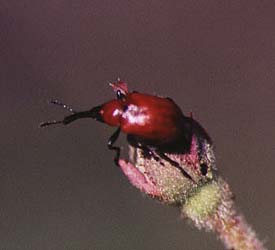
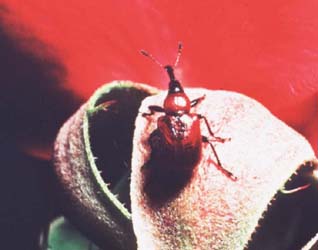
Rose weevil adults on rose buds.
The rose curculio or rose weevil is a reddish and black weevil with a distinctive long snout on the head. It is about 1/4 inch (5-6 mm) in body lenght. The snout is used for drilling and feeding on flower buds. Its scientific name is Merhynchites (=Rhynchites) bicolor Fabricius and it is a member of the Order Coleoptera, Family Curculionidae. It occurs throughout the United States. There are several color forms which at various times have been recognized as species or subspecies.


Rose weevil adults on rose buds.

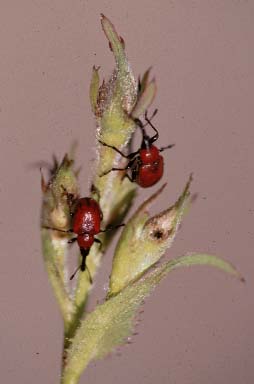
Bud damage to immature buds of roses. Weevils use the buds for feeding and laying their eggs.
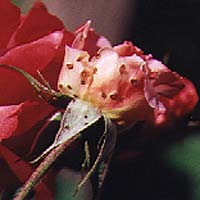

Petal damage to opening blooms damaged by the rose weevils
Rose weevils damage to roses in several different ways. First the weevils damage roses by making feeding punctures with their long beaks on rose buds, calyx, and peduncle. Secondly the weevils lay their eggs in the buds and the larvae feed on the petals and receptacle area. If any flowers manage to open, the petals show distinct small holes made by the adults.
The adults drill small round holes deep into the flower buds and hips for feeding and egg-laying. Eggs are usually laid in the hip or ovary and the small white larvae feed on the reproductive parts. The greatest damage to roses is cause when adults feed on flower buds. The adult punctures the floral parts contained inside buds. Later, if the flowers suceed in opeining, these flowral parts are riddled with holes, resulting in ragged , unsightly blossoms. If flower buds are not plentiful, the adult curculio may feed on the tips of new rose shoots, causing the death of terminals. At other times it gouges the stems of buds, causing the bud to wilt and die.
LIFE CYCLE: Adults emerge from the soil in the spring and they look for young, flower buds to feed on and lay their eggs. After a few days the larvae hatch from the eggs and feed on the reproductive parts of the flower buds. The larvae may continue development on buds that remain on the plant and on those that fall to the ground. Fully grown larvae They also feed on rose hips, which are located below the bud. The adults drill holes in the hip or bud for food. Then they turn around and lay there eggs. Since the adult made holes in the buds, the peduncle (stem right below the hip) becomes weak and eventually the buds fall off. The larva emerges from the fallen rose bud and then burrows into the soil where it hibernates (overwinters). In late winter or early spring depending on the soil temperature, the larva turns into a pupa and after a few days, the adult emerge from the pupa and from the soil to start the life cycle over again. There is only one generation per year.
CONTROL: Scouting or monitoring for the presence of rose weevils is very important for adequate control. Rose weevils start to damage roses at the first sight of bud formation and they tend to prefer certain roses more than others. Keeping notes on varietal preference is important for successful scouting the and control of the weevils early before they cause widespread damage on the roses. In the absence of buds on preferred varieties, the weevils will feed on growing tips.
Regular handpicking of the adult weevils and removal of damaged buds and spent blossoms will prevent continuing damage and will prevent severe populations the following year. Scouting and handpicking should also be done on other hosts such as raspberries and boysenberries, and blackberries. Adult weevils drop readily from plants and feign death when disturbed. In order to take advantage of this behavior, collect the adult curculios with a wide mouth container half full of soapy water. Touch the plant parts where the weevils are feeding and they readily fall down into the soapy water and drown. Rose buds or entire rose bushes can be protected using a netting material that allows sunlight and water to penetrate but excludes insects. Bonnets made with a material called "remay" have been used successfully by rosarians in parts of the United States to exclude insect pests like Japanese beetles, cucumber beetles, and even thrips. Parasitic nematodes can be used against rose weevil larvae provided that larval populations are located prior to spring emergence. Gardens where the infested buds are allowed to fall to the soil would be prime candidates for this biological control method.
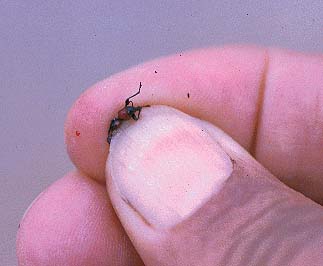
Hand picking is a very effective method of dealing with this annoying pest in the early spring months. In my garden near Sacramento, California the weevils usually show up from early April thorough early May.
If the above control methods do not achieve satisfactory control, chemical insecticides may be are considered for larval and adult weevil control. If a larvae are recovered from the soil, insecticides registered for soil use can be used around the rose bushes in order to kill the soil ihnabiting larvae and emerging weevils. Insecticides can also be sprayed at the first sign of the weevils presence in the spring. Insecticides used in the control of beetles on roses and other ornamentas should work on these weevils. Please check the label and read all the precautions on the insecticide label before using any insecticides.
REFERENCES:
Cranshaw, W. Pests of the West -- Preventiona and Control for Today=s Garden and Small Farm. Fulcrum Publishing, Golden, Colorado, p. 97.
Essig, E. O. 1926. Insects of Western North America. The MacMillan Company, NY, p. 488-9.
Johnson, Warren T. and Howard H. Lyon. 1988. Insects that Feed on Trees and Shrubs,, 2nd edition, Cornell University Press, Ithaca, NY., pp 238-9.
![]()
If you have any questions or constructive comments, I would love to hear from you, please send e-mail to Baldo Villegas
[Home]
[Rose Pests Master List]
[Rose Diseases]
[Insect, Mites, and other Animal Pests]
[Abiotic Rose Problems]
[Weed Pests]
[Hawaii Pests]
[The Good Guys]
[Help! Rose IPM]
[Horticulure Links]
Copyright© 1995-2005 by Baldo Villegas
Last updated:
Wednesday, October 26, 2005 10:13 PM